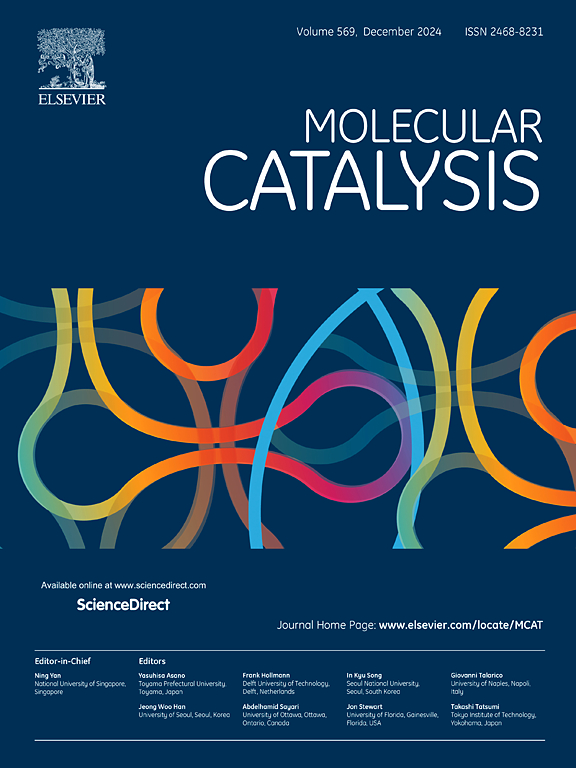Co nanoclusters derived from zinc-trimesic acid fiber for efficient levulinic acid hydrogenation
IF 3.9
2区 化学
Q2 CHEMISTRY, PHYSICAL
引用次数: 0
Abstract
The hydrogenation of levulinic acid (LA) to γ-valerolactone (GVL) is significant for producing chemicals and fuels from renewable resources, a promising direction in biomass refining. Currently, non-precious metal catalysts suffer from low activity due to a single electronic structure, which is incapable of effectively activating both C![]() O in LA and H2. Herein we report in situ fabricated Co nanoclusters within positive and metallic Co sites on N-doped carbon, which can simultaneously activate LA's C
O in LA and H2. Herein we report in situ fabricated Co nanoclusters within positive and metallic Co sites on N-doped carbon, which can simultaneously activate LA's C![]() O and H2, enhancing the activity and selectivity for GVL production. Urea-assisted Co dispersion coupled with variation of pyrolysis temperature, Co nanoclusters were formed via direct conversion of Co-containing zinc trimesic acid fibers. The resulting Co nanoclusters possess dual active sites of Co-Nx and metallic Co, with adjustable electronic structures. Under the reaction conditions of 200 °C and 4.5 MPa H2 for 4 h, LA was completely converted, achieving 95 % yield of GVL. The outstanding catalytic activity is attributed to the Co-Nx and metallic Co active sites, which facilitate the activation of C
O and H2, enhancing the activity and selectivity for GVL production. Urea-assisted Co dispersion coupled with variation of pyrolysis temperature, Co nanoclusters were formed via direct conversion of Co-containing zinc trimesic acid fibers. The resulting Co nanoclusters possess dual active sites of Co-Nx and metallic Co, with adjustable electronic structures. Under the reaction conditions of 200 °C and 4.5 MPa H2 for 4 h, LA was completely converted, achieving 95 % yield of GVL. The outstanding catalytic activity is attributed to the Co-Nx and metallic Co active sites, which facilitate the activation of C![]() O and H2, respectively. This research provides a new concept for converting N-free metal-organic frameworks into non-precious metal nanoclusters, offering valuable insights for designing high-performance non-precious metal catalysts for biomass-derived chemical and fuel production.
O and H2, respectively. This research provides a new concept for converting N-free metal-organic frameworks into non-precious metal nanoclusters, offering valuable insights for designing high-performance non-precious metal catalysts for biomass-derived chemical and fuel production.

从三聚氰锌纤维中提取钴纳米团簇用于乙酰丙酸的高效加氢
乙酰丙酸(LA)加氢制γ-戊内酯(GVL)对于利用可再生资源生产化学品和燃料具有重要意义,是生物质精炼的一个有前景的方向。目前,非贵金属催化剂由于电子结构单一,活性较低,无法同时有效激活LA和H2中的CO。本文报道了在n掺杂碳的正离子和金属离子上原位制备的Co纳米团簇,它可以同时激活LA的Co和H2,提高GVL产生的活性和选择性。尿素辅助Co分散加上热解温度的变化,使含Co的三羧酸锌纤维直接转化形成Co纳米团簇。得到的Co纳米团簇具有Co- nx和金属Co的双活性位点,具有可调节的电子结构。在200℃、4.5 MPa H2条件下反应4 h, LA完全转化,GVL产率达到95%。Co- nx和金属Co活性位点分别促进了Co和H2的活化,具有优异的催化活性。该研究为将无n金属有机骨架转化为非贵金属纳米团簇提供了一个新概念,为设计用于生物质衍生化学和燃料生产的高性能非贵金属催化剂提供了有价值的见解。
本文章由计算机程序翻译,如有差异,请以英文原文为准。
求助全文
约1分钟内获得全文
求助全文
来源期刊

Molecular Catalysis
Chemical Engineering-Process Chemistry and Technology
CiteScore
6.90
自引率
10.90%
发文量
700
审稿时长
40 days
期刊介绍:
Molecular Catalysis publishes full papers that are original, rigorous, and scholarly contributions examining the molecular and atomic aspects of catalytic activation and reaction mechanisms. The fields covered are:
Heterogeneous catalysis including immobilized molecular catalysts
Homogeneous catalysis including organocatalysis, organometallic catalysis and biocatalysis
Photo- and electrochemistry
Theoretical aspects of catalysis analyzed by computational methods
 求助内容:
求助内容: 应助结果提醒方式:
应助结果提醒方式:


